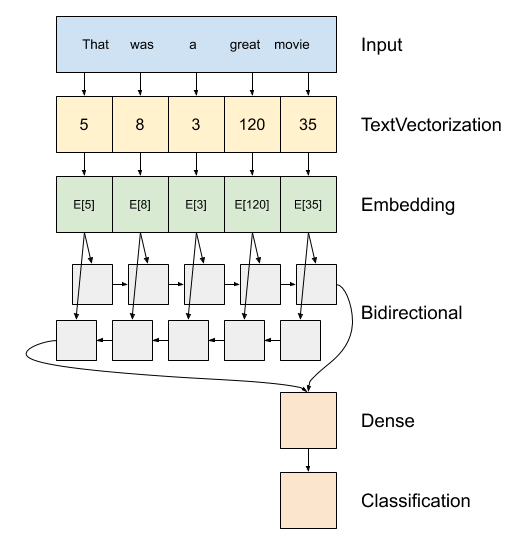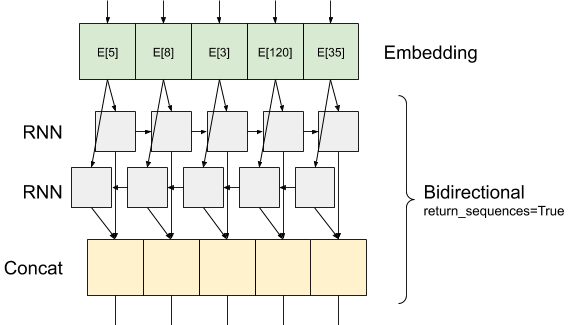 View on TensorFlow.org View on TensorFlow.org
|
 Run in Google Colab Run in Google Colab
|
 View source on GitHub View source on GitHub
|
 Download notebook Download notebook
|
This text classification tutorial trains a recurrent neural network on the IMDB large movie review dataset for sentiment analysis.
Setup
import numpy as np
import tensorflow_datasets as tfds
import tensorflow as tf
tfds.disable_progress_bar()
Import matplotlib and create a helper function to plot graphs:
import matplotlib.pyplot as plt
def plot_graphs(history, metric):
plt.plot(history.history[metric])
plt.plot(history.history['val_'+metric], '')
plt.xlabel("Epochs")
plt.ylabel(metric)
plt.legend([metric, 'val_'+metric])
Setup input pipeline
The IMDB large movie review dataset is a binary classification dataset—all the reviews have either a positive or negative sentiment.
Download the dataset using TFDS. See the loading text tutorial for details on how to load this sort of data manually.
dataset, info = tfds.load('imdb_reviews', with_info=True,
as_supervised=True)
train_dataset, test_dataset = dataset['train'], dataset['test']
train_dataset.element_spec
Initially this returns a dataset of (text, label pairs):
for example, label in train_dataset.take(1):
print('text: ', example.numpy())
print('label: ', label.numpy())
Next shuffle the data for training and create batches of these (text, label) pairs:
BUFFER_SIZE = 10000
BATCH_SIZE = 64
train_dataset = train_dataset.shuffle(BUFFER_SIZE).batch(BATCH_SIZE).prefetch(tf.data.AUTOTUNE)
test_dataset = test_dataset.batch(BATCH_SIZE).prefetch(tf.data.AUTOTUNE)
for example, label in train_dataset.take(1):
print('texts: ', example.numpy()[:3])
print()
print('labels: ', label.numpy()[:3])
Create the text encoder
The raw text loaded by tfds needs to be processed before it can be used in a model. The simplest way to process text for training is using the TextVectorization layer. This layer has many capabilities, but this tutorial sticks to the default behavior.
Create the layer, and pass the dataset's text to the layer's .adapt method:
VOCAB_SIZE = 1000
encoder = tf.keras.layers.TextVectorization(
max_tokens=VOCAB_SIZE)
encoder.adapt(train_dataset.map(lambda text, label: text))
The .adapt method sets the layer's vocabulary. Here are the first 20 tokens. After the padding and unknown tokens they're sorted by frequency:
vocab = np.array(encoder.get_vocabulary())
vocab[:20]
Once the vocabulary is set, the layer can encode text into indices. The tensors of indices are 0-padded to the longest sequence in the batch (unless you set a fixed output_sequence_length):
encoded_example = encoder(example)[:3].numpy()
encoded_example
With the default settings, the process is not completely reversible. There are three main reasons for that:
- The default value for
preprocessing.TextVectorization'sstandardizeargument is"lower_and_strip_punctuation". - The limited vocabulary size and lack of character-based fallback results in some unknown tokens.
for n in range(3):
print("Original: ", example[n].numpy())
print("Round-trip: ", " ".join(vocab[encoded_example[n]]))
print()
Create the model

Above is a diagram of the model.
This model can be build as a
tf.keras.Sequential.The first layer is the
encoder, which converts the text to a sequence of token indices.After the encoder is an embedding layer. An embedding layer stores one vector per word. When called, it converts the sequences of word indices to sequences of vectors. These vectors are trainable. After training (on enough data), words with similar meanings often have similar vectors.
This index-lookup is much more efficient than the equivalent operation of passing a one-hot encoded vector through a
tf.keras.layers.Denselayer.A recurrent neural network (RNN) processes sequence input by iterating through the elements. RNNs pass the outputs from one timestep to their input on the next timestep.
The
tf.keras.layers.Bidirectionalwrapper can also be used with an RNN layer. This propagates the input forward and backwards through the RNN layer and then concatenates the final output.The main advantage of a bidirectional RNN is that the signal from the beginning of the input doesn't need to be processed all the way through every timestep to affect the output.
The main disadvantage of a bidirectional RNN is that you can't efficiently stream predictions as words are being added to the end.
After the RNN has converted the sequence to a single vector the two
layers.Densedo some final processing, and convert from this vector representation to a single logit as the classification output.
The code to implement this is below:
model = tf.keras.Sequential([
encoder,
tf.keras.layers.Embedding(
input_dim=len(encoder.get_vocabulary()),
output_dim=64,
# Use masking to handle the variable sequence lengths
mask_zero=True),
tf.keras.layers.Bidirectional(tf.keras.layers.LSTM(64)),
tf.keras.layers.Dense(64, activation='relu'),
tf.keras.layers.Dense(1)
])
Please note that Keras sequential model is used here since all the layers in the model only have single input and produce single output. In case you want to use stateful RNN layer, you might want to build your model with Keras functional API or model subclassing so that you can retrieve and reuse the RNN layer states. Please check Keras RNN guide for more details.
The embedding layer uses masking to handle the varying sequence-lengths. All the layers after the Embedding support masking:
print([layer.supports_masking for layer in model.layers])
To confirm that this works as expected, evaluate a sentence twice. First, alone so there's no padding to mask:
# predict on a sample text without padding.
sample_text = ('The movie was cool. The animation and the graphics '
'were out of this world. I would recommend this movie.')
predictions = model.predict(np.array([sample_text]))
print(predictions[0])
Now, evaluate it again in a batch with a longer sentence. The result should be identical:
# predict on a sample text with padding
padding = "the " * 2000
predictions = model.predict(np.array([sample_text, padding]))
print(predictions[0])
Compile the Keras model to configure the training process:
model.compile(loss=tf.keras.losses.BinaryCrossentropy(from_logits=True),
optimizer=tf.keras.optimizers.Adam(1e-4),
metrics=['accuracy'])
Train the model
history = model.fit(train_dataset, epochs=10,
validation_data=test_dataset,
validation_steps=30)
test_loss, test_acc = model.evaluate(test_dataset)
print('Test Loss:', test_loss)
print('Test Accuracy:', test_acc)
plt.figure(figsize=(16, 8))
plt.subplot(1, 2, 1)
plot_graphs(history, 'accuracy')
plt.ylim(None, 1)
plt.subplot(1, 2, 2)
plot_graphs(history, 'loss')
plt.ylim(0, None)
Run a prediction on a new sentence:
If the prediction is >= 0.0, it is positive else it is negative.
sample_text = ('The movie was cool. The animation and the graphics '
'were out of this world. I would recommend this movie.')
predictions = model.predict(np.array([sample_text]))
Stack two or more LSTM layers
Keras recurrent layers have two available modes that are controlled by the return_sequences constructor argument:
If
Falseit returns only the last output for each input sequence (a 2D tensor of shape (batch_size, output_features)). This is the default, used in the previous model.If
Truethe full sequences of successive outputs for each timestep is returned (a 3D tensor of shape(batch_size, timesteps, output_features)).
Here is what the flow of information looks like with return_sequences=True:

The interesting thing about using an RNN with return_sequences=True is that the output still has 3-axes, like the input, so it can be passed to another RNN layer, like this:
model = tf.keras.Sequential([
encoder,
tf.keras.layers.Embedding(len(encoder.get_vocabulary()), 64, mask_zero=True),
tf.keras.layers.Bidirectional(tf.keras.layers.LSTM(64, return_sequences=True)),
tf.keras.layers.Bidirectional(tf.keras.layers.LSTM(32)),
tf.keras.layers.Dense(64, activation='relu'),
tf.keras.layers.Dropout(0.5),
tf.keras.layers.Dense(1)
])
model.compile(loss=tf.keras.losses.BinaryCrossentropy(from_logits=True),
optimizer=tf.keras.optimizers.Adam(1e-4),
metrics=['accuracy'])
history = model.fit(train_dataset, epochs=10,
validation_data=test_dataset,
validation_steps=30)
test_loss, test_acc = model.evaluate(test_dataset)
print('Test Loss:', test_loss)
print('Test Accuracy:', test_acc)
# predict on a sample text without padding.
sample_text = ('The movie was not good. The animation and the graphics '
'were terrible. I would not recommend this movie.')
predictions = model.predict(np.array([sample_text]))
print(predictions)
plt.figure(figsize=(16, 6))
plt.subplot(1, 2, 1)
plot_graphs(history, 'accuracy')
plt.subplot(1, 2, 2)
plot_graphs(history, 'loss')
Check out other existing recurrent layers such as GRU layers.
If you're interested in building custom RNNs, see the Keras RNN Guide.
